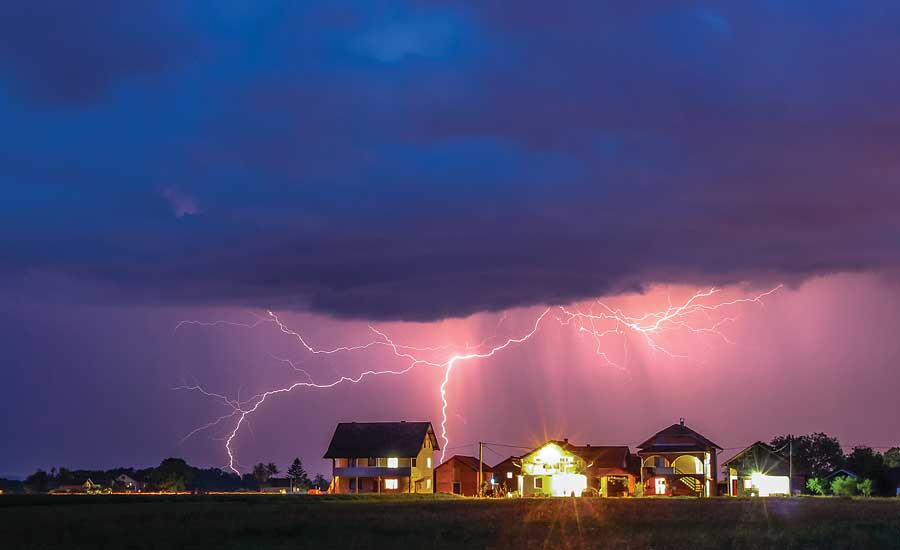I often receive requests to write a column on certain issues. The most requested subject matter, by far, is the new sizing method for roof (storm) drainage systems. Since the ICC International Plumbing Code adopted the new sizing methods there seems to be plenty of confusion.
For the last 100 years, storm drainage systems have been sized incorrectly by simply assuming that a pipe of a given size flows so much water based on the amount of rain falling from the sky. Hence, the storm drainage systems have been sized using the stack equation and assuming a 33% capacity of water while the horizontal drains have been sized using the Manning equation and assuming full flow (while sanitary drainage is half flow). So why is this wrong?
In a roof drainage system, you have many components. The pipe sizing is only one component. That is what is wrong. The sizing of the roof drainage system must consider all components: the rain storm, the flow of rainwater on the roof surface, the ability of the roof drain to move the water from the roof to the piping, the vertical piping, the horizontal piping and the connection to the point of discharge.
For years, what we ignored is not following a systems approach in sizing. We have ignored how fast the water gets off the roof and how efficient the roof drains are. An ASPE Research Foundation report indicates the roof drains that are commercially available are fantastic (The ASPE Research Foundation Roof Drainage Research Report is available for download online at www.aspe.org). Roof drains can move water off the roof a lot more efficiently than an open hole connecting to the piping. For so long many plumbing engineers assumed an open hub pipe would flow more water than a roof drain. The assumption was the roof drain obstructed the flow of water. As it turns out, the opposite is true of most roof drains. The flow through the roof drain is very efficient, directing the water into the drain.
The end result is roof drains 6 in. or smaller in size have the ability to flow more water to the piping than the piping can handle, using 33% for the vertical and full flow for the horizontal. What that means is under a heavy rain occurrence, the roof drainage piping is pressurized rather than flowing under an open-channel flow condition. When you pressurize a storm drainage system, pipes blow apart inside the building.
Interestingly, the opposite is true if you have a roof drain larger than 6 in. The roof drain typically will not remove the water as fast as you may think. The result is a roof collapse.
Following this logic it is possible that for roof drains 6 in. or less in diameter, the piping will be larger in diameter than the roof drain; for example, a 4-in. roof drain connected to a 6-in. pipe. For larger roof drains, the pipe may be smaller, such as a 10-in. roof drain connected to an 8-in. pipe.
Run the test
What some people have been reading into this sizing method is that it picks on the roof drain manufacturers. That couldn’t be further from the truth. The roof drain is one part of the system. However, as a part of the system, you need to know how efficient the roof drain is. This is information that the roof drain manufacturers must provide to the engineer.
There is a test method for determining the flow rate through the roof drain — ASPE/IAPMO Z1034. This standard requires the manufacturers to publish the flow rate based on the amount of ponding around the roof drain. Typically, the greater the ponding, the higher the flow rate through the roof drain.
This also means you need to determine the amount of ponding that can occur at the roof drain. That calculation is rather easy as it is based on a severe storm and the rainwater flow rate from the roof surface to the roof drain. I have found that microbursts (five-minute storm, 10-year return period) are sometimes more controlling in the sizing of the roof drainage system than a 100-year storm. But this depends on the design and shape of the roof and the location of the roof drains.
One of the issues raised by engineers is roof drain manufacturers are not providing the flow rates for their roof drains. Therefore, how can you size the system? Without knowing the flow rate through the roof drain, you cannot properly size a system.
I have spoken to most of the roof drain manufacturers. Some think the new sizing method is great and about time that it was implemented. Others want to shoot me. Some manufacturers think if they provide flow rate information, they become liable. I’m not sure what they are liable for since the test labs or third-party agencies certify the results and all the manufacturer does is report them to the engineer. As an engineer, you become liable if you don’t use the numbers correctly.
Three roof drain manufacturers have informed me that they either are or soon will be publishing the flow rate values through their roof drains. This is good and it may turn out that engineers only will be specifying those roof drains. Of course, shortly thereafter, other manufacturers will realize they need to publish the flow data if they want their roof drains specified.
The sizing methodology is rather straight forward:
A. Determine the most demanding rainstorm for the roof design (microburst or 100-year);
B. Determine the runoff rate of the rainwater to the roof drain;
C. Select a roof drain that provides the required capacity for removing the rainwater based on the flow rate; and
D. Size the piping based on the flow rate through the roof drain.
I’m often asked if there is a simplified method for sizing using the old inaccurate method. You probably could. I would suggest if you take the rainfall rate for your area for a storm of one-hour duration and 100-year return period and double the rainfall rate, you probably would end up with a conservative enough design to work under most major rainstorms.
You still are better off using the new sizing method, whether your plumbing code has adopted it or not. It is the only way to assure a proper design of the roof drainage system.
This article was originally titled “Down the pipe” in the March 2017 print edition of PM Engineer.



